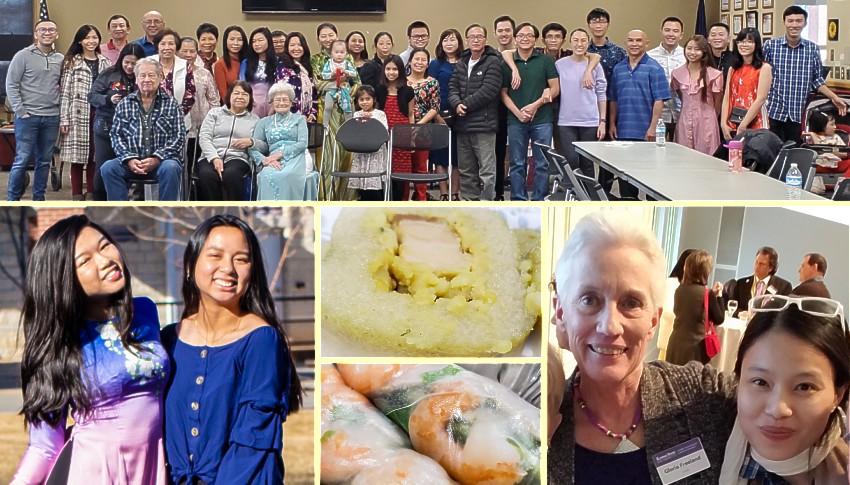Kansas Snapshots by Gloria Freeland - February 7, 2020
"Chúc mừng năm mới!"
I was recently invited by Vietnamese colleague and friend Huyen (hwee-uhn) to a Lunar New Year party. The end of 2019 and the
start of 2020 here in the Western world was a few weeks ago. That New Year’s didn’t involve any celebrating for husband Art and
me as we were on our way to his home state of Wisconsin to visit relatives and friends. We stopped in Dubuque, Iowa for the night
and had a meal at a bustling Asian buffet before retiring early. I cannot recall if we stayed awake long enough to see the new year
in.
The date we Americans set for our new year is actually quite arbitrary. Until 1752, here and in Great Britain, March 25 was the
day when the old year finished and the new one began. In contrast, some other cultures place great importance on celestial
cycles such as the movement of the moon and the sun.
I wasn't able to accept Huyen's invitation because Art and I had already made plans to celebrate a late Christmas with his
daughter Karen and family in Kansas City. But her offer sparked my curiosity and prompted me to ask how she celebrates the
Lunar New Year.
She said her family traditions include gift-giving, spending time with family and friends, and food.
My family always go to visit my two grandmothers and other seniors in the community. When I was a child, I received lucky money
(lì xì) from them. When I had my first job, I started doing the opposite way.
My grandmother on my mother's side always cooked Southern Vietnamese foods for Tet Holidays, especially the White Tiny Onion
Pickles (Cư Kiêu), Caramelized Pork and Eggs (Thit Kho Tàu) and Prawns in Roe Sauce (Tôm Càng Kho).
My grandmother on my father’s side always made Northern Vietnamese foods such as Square Cakes (Bánh Chung) and Candied
Kumquats/Gingers/Coconut ....
She said sticky rice and boiled chicken are also popular.
In their daily lives, Asians use the same calendar we do. But for special events, such as the Lunar New Year, the traditional
Chinese calendar is used, and it is tied to the cycles of the moon. Because the moon requires about 29 1/2 days to revolve
around the earth, all Chinese calendar months are 29 or 30 days long. Since there are 12 Chinese months, at the end of the
Chinese year, approximately 354 days have passed ... about 11 short of the solar year. So, about every two years, an extra
ninth month is added. The Lunar New Year begins on the new moon that appears between Jan. 21 and Feb. 20.
This system is used by millions of people in China, Indonesia, Japan, Korea, Vietnam and other countries. By basing the new year
on these cycles, much like our Easter, the Lunar New Year will not appear on the same date every year. This year, Lunar New Year
began on Jan. 25.
Chinese years are grouped in a 12-year cycle or zodiac. Each is assigned to an animal and that animal is considered to have
certain attributes. This year is the "Year of the Rat" and while I doubt many people would consider it to be a particularly cute
animal, it ranks first on the Chinese zodiac. It is sometimes described as an animal with "spirit, wit, alertness, delicacy,
flexibility and vitality."
Hmm! I paused to consider how a rat might display wit.
Huyen said, "It’s how the Asian calendar works. To me, I do not delve deeper into the horoscopes, so that the year has no special
meaning."
Huyen said there is a belief that when a person's particular "year" comes around, he or she may have bad luck that year. "I just
know that I was born in the Year of Mickey Mouse and older people advised me to be more careful this year because bad things may
happen. I hope not."
Huyen said her parents always buy potted plants, especially daisies, mums and other flowers for the holiday. Red and yellow are
strongly associated with the occasion. Red means luck and yellow means wealth.
At the recent Lunar New Year party in Manhattan, Huyen took spring rolls with lemongrass shrimp. Other foods served to the 35-40
people in attendance included Banh Tet (Tet cake) and Che Thung (mung beans with tapioca and seaweed).
Huyen sent me photos of the group, the food, and two young women with one in an "Ao Dai" - a traditional Vietnamese costume.
Her photos and descriptions almost made me feel as if I'd been there. I'm certain it would have been interesting and I would
have liked to try the food.
Maybe Karen knew what was on my mind for as we were arranging to go to Kansas City, she texted, "We found a great new Chinese
buffet for lunch."
I don't know if the buffet was authentic, but I have to admit, it pleased my palate.
"Chúc mừng năm mới!" - Happy Lunar New Year!
